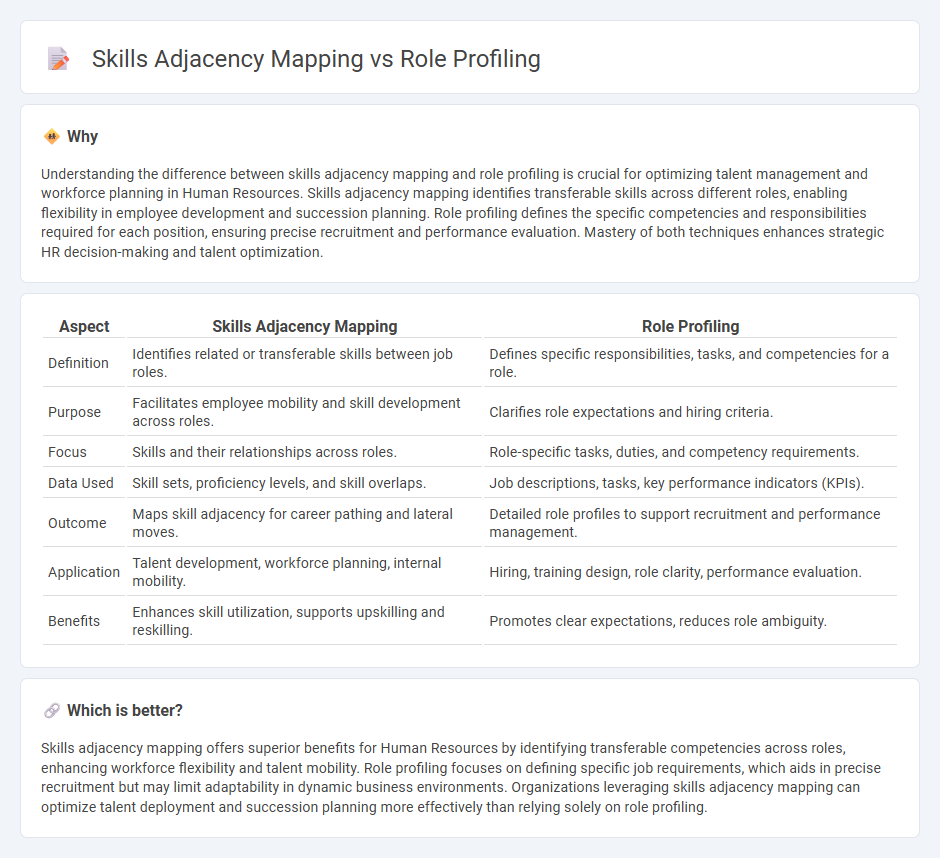
Skills adjacency mapping identifies transferable competencies across different roles, enhancing workforce agility and internal mobility. Role profiling defines specific job requirements, outlining essential skills and qualifications to optimize candidate matching and performance evaluation. Explore how integrating both approaches can improve talent management strategies.
Why it is important
Understanding the difference between skills adjacency mapping and role profiling is crucial for optimizing talent management and workforce planning in Human Resources. Skills adjacency mapping identifies transferable skills across different roles, enabling flexibility in employee development and succession planning. Role profiling defines the specific competencies and responsibilities required for each position, ensuring precise recruitment and performance evaluation. Mastery of both techniques enhances strategic HR decision-making and talent optimization.
Comparison Table
| Aspect | Skills Adjacency Mapping | Role Profiling |
|---|---|---|
| Definition | Identifies related or transferable skills between job roles. | Defines specific responsibilities, tasks, and competencies for a role. |
| Purpose | Facilitates employee mobility and skill development across roles. | Clarifies role expectations and hiring criteria. |
| Focus | Skills and their relationships across roles. | Role-specific tasks, duties, and competency requirements. |
| Data Used | Skill sets, proficiency levels, and skill overlaps. | Job descriptions, tasks, key performance indicators (KPIs). |
| Outcome | Maps skill adjacency for career pathing and lateral moves. | Detailed role profiles to support recruitment and performance management. |
| Application | Talent development, workforce planning, internal mobility. | Hiring, training design, role clarity, performance evaluation. |
| Benefits | Enhances skill utilization, supports upskilling and reskilling. | Promotes clear expectations, reduces role ambiguity. |
Which is better?
Skills adjacency mapping offers superior benefits for Human Resources by identifying transferable competencies across roles, enhancing workforce flexibility and talent mobility. Role profiling focuses on defining specific job requirements, which aids in precise recruitment but may limit adaptability in dynamic business environments. Organizations leveraging skills adjacency mapping can optimize talent deployment and succession planning more effectively than relying solely on role profiling.
Connection
Skills adjacency mapping enhances role profiling by identifying complementary and transferable skills that expand the competency framework for specific job roles. Integrating skills adjacency data into role profiling enables Human Resources to design more accurate job descriptions, improve talent acquisition strategies, and support targeted employee development. This connection facilitates workforce agility by aligning skill sets with evolving organizational needs and career progression pathways.
Key Terms
Job Description
Role profiling involves creating detailed descriptions of job responsibilities, required skills, and competencies to align candidates with specific positions, enhancing recruitment accuracy and employee performance management. Skills adjacency mapping identifies related or complementary skills to broaden candidate pools and support workforce development by highlighting training needs and career progression paths. Explore how these methods optimize job description effectiveness and talent acquisition strategies.
Competency Framework
Role profiling centers on defining specific responsibilities and required competencies within a Competency Framework, ensuring each position aligns precisely with organizational goals. Skills adjacency mapping identifies overlapping or complementary skills across roles, facilitating workforce flexibility and targeted development pathways. Explore how integrating these approaches can enhance talent management strategies.
Skill Gaps
Role profiling identifies the key responsibilities and competencies required for specific job positions, while skills adjacency mapping analyzes the proximity between existing and desired skills within an organization. Addressing skill gaps becomes more precise by combining role profiling with skills adjacency mapping, enabling targeted training and strategic workforce planning. Explore how integrating these approaches can enhance your talent development strategies.
Source and External Links
Role-based skill profiling: Key benefits and strategies - Role-based skill profiling is the structured process of identifying, documenting, and evaluating the skills, knowledge, and behaviors required for effective performance in a specific job role, serving as a blueprint for success and clarifying expectations for both employers and employees.
The best practices for creating a job profile - A job profile is a detailed description of the duties, responsibilities, required skills, and qualifications for an individual position, while a role profile takes a broader view, encompassing expectations and responsibilities for a particular role that may include multiple, similar positions within an organization.
Competency Profiles - Role Profiling, Examples, Meanings - A competency profile lists the relevant competencies at specific proficiency levels required for a job, providing concrete, measurable requirements to define what is needed for effective role performance.
 dowidth.com
dowidth.com